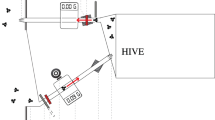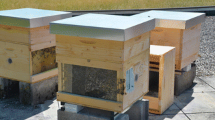Abstract
This study experimentally examines the relationship between colony state and the behaviour of individual pollen and nectar foragers in the honey bee, Apis mellifera L. In the first experiment we test the prediction that individual pollen foragers from colonies with higher brood quantities should exhibit a greater work effort for pollen resources than individual pollen foragers from colonies with low brood quantities. Eight colonies were assigned into two treatment groups; HIGH brood colonies were manipulated to contain 9600±480 cm2 brood area; LOW brood colonies were manipulated to contain 1600±80 cm2 brood area. We measured colony brood levels over the course of the experiment and collected individual pollen loads from returning pollen foragers. We found that, while colonies remained significantly different in brood levels, individual pollen foragers from HIGH brood colonies collected larger loads than individuals from LOW brood colonies. In the second experiment we investigated the influence of colony size on the behaviour of individual nectar foragers. We assigned eight colonies to two treatment groups; LARGE colonies were manipulated to contain 35000±1700 adult workers with 3500±175 cm2 brood area, and SMALL colonies were manipulated to contain 10000±500 adult workers with 1000±50 cm2 brood area. We observed foraging trips of individually marked workers and found that individuals from LARGE colonies made longer foraging trips than those from SMALL colonies (LARGE: 1666.7±126.4 seconds, SMALL: 1210.8±157.6 seconds), and collected larter nectar loads (LARGE: 19.2±1.0 μl, SMALL: 14.6±0.8 μl). These results indicate that individual nectar foragers from LARGE colonies tend to work harder than individuals from SMALL colonies. Both experiments indicate that the values of nectar and pollen resources to a colony change depend on colony state, and that individual foragers modify their behaviour accordingly.
Similar content being viewed by others
References
Al-Tikrity WS, Benton AW, Hillman RC, Clarke WW (1972) The relationship between the amount of unsealed brood in honey bee colonies and their pollen collection. J Apic Res 11:9–12
Barker RL (1971) The influence of food inside the hive on pollen collection by a honey bee colony. J Apic Res 10:23–26
Beauchamp G (1992) Effects of energy requirements and worker mortality on colony growth and foraging in the honey bee. Behav Ecol Sociobiol 31:123–132
Bolten AB, Feinsinger P, Baker HG, Baker I (1979) On the calculation of sugar concentration in flower nectar. Oecologia 41:301–304
Cale GH (1968) Pollen gathering relationship to honey collection and egg laying in honey bees. Am Bee J 108:8–9
Camazine S (1993) The regulation of pollen foraging by honey bees: how foragers assess the colony's need for pollen. Behav Ecol Sociobiol 32:265–272
Cole BJ (1984) Colony efficiency and the reproductivity effect in Leptothorax allardycei (Mann). Insectes Sociaux 31:403–407
Crailsheim K (1991) Interadult feeding of jelly in honeybee (Apis mellifera L.) colonies. J Comp Physiol 161:55–60
Fergusson LA, Winston ML (1988) The influence of wax deprivation on temporal caste structure in honey bee (Apis mellifera L.) colonies. Can J Zool 66: 1997–2001
Fewell JH, Winston ML (1992) Coloney state and regulation of pollen foraging in the honey bee, Apis mellifera L. Behav Ecol Sociobiol 30:387–393
Filmer RS (1932) Brood area and colony size as factors in activity of pollination units. J Econ Entomol 25:336–343
Free JB (1967) Factors determining the collection of pollen by honey bee foragers. Anim Behav 15:134–144
Fukuda H (1960) Some observations on the pollen foraging activities of the honey bee, Apis mellifera L. (preliminary report). J Fac Sci Hokkaido University (ser 6) 14:381–386
Higo H, Colley S, Winston ML, Slessor K (1992) Effects of honey bee (Apis mellifera L.) queen mandibular gland pheromone on foraging and brood rearing. Can Entomol 124:409–418
Houston AI, Schmid-Hempel P, Kacelnik A (1988) Poraging strategies, worker mortality and the growth of the colony in social insects. Am Nat 131:107–114
Inouyé DW, Favre ND, Lanum JA, Levine DM, Meyers JB, Roberts MS, Tsao FC, Wang Y-Y (1980) The effects of nonsugar nectar constituents on estimates of nectar energy content. Ecology 61:992–996
Jaycox ER (1970a) Honey bee queen pheromones and worker foraging behaviour. Ann Entomol Soc Am 63:222–228
Jaycox ER (1970b) Honey bee foraging behaviour: responses to queens, larvae, and extracts of larvae. Ann Entomol Soc Am 63:1689–1694
Lee PC, Winston ML (1987) Effect of reproductive timing and colony size on survival, offspring colony size and drone production in the honey bee (Apis mellifera). Ecol Entomol 12:187–195
Little M (1979) Mischocyttarus flayipes in Arizona: social and nesting biology of a polistine wasp. Z Tierpsychol 50:282–312
Michener CD (1964) Reproductive efficiency in relation to colony size in hymenopterous societies. Insesctes Sociaux 11:317–342
Moeller FE (1972) Honey bee collection of corn pollen reduced by feeding pollen in the hive. Am Bee J 112:210–212
Morton K (1950) The food of worker bees of different ages. Bee World 32:78–79
Neukirch A (1982) Dependence of life span of the honey bee (Apis mellifera) upon flight performance and energy consumption. J Comp Physiol 146:35–40
Otis GW, Winston ML, Taylor OR (1981) Engorgement and dispersal of Africanized honey bee swarms. J Apic Res 20:3–12
Pomeroy N (1979) Brood bionomics of Bombus ruderatus in New Zealand (Hymenoptera: Apidae). Can Entomol 111:865–874
Richards OW, Richards WJ (1951) Observations on the social wasps in South America (Hymenoptera: Vespidae). Trans' R Entomol Soc 102:1–170
Rinderer TE (1981) Volatiles from empty comb increase hoarding by the honey bee. J Apic Res 24:161–167
Schmid-Hempel P, Winston MC, Ydenberg RC (1993) Invitation paper (C.P. Alexander Fund): Foraging of individual workers in relation to colony state in the social Hymenoptera Can Entomol 125:129–160
Seeley TD (1985) Honeybee Ecology. Princeton University Press, Princeton, NJ
Seeley TD (1989) Social foraging in the honeybee: How nectar foragers assess their colony's nutritional status. Behav Ecol Sociobiol 24:181–198
Seeley TD, Wisscher PK (1985) Survial of honey bees in cold climates: the critical timing of colony growth and reproduction. Ecol Entomol 10:81–88
Sokal R, Rohlf FJ (1981) Biometry. 2nd Ed. WH Freedman and Co., New York, NY
Todd FE, Reed CB (1970) Brood measurement as a valid index to the value of honey bees as pollinators. J Econ Entomol 63:148–149
Winston ML (1987) The Biology of the Honey Bee. Harvard University Press, Cambridge, Mass
Winston ML, Fergusson LA (1985) The effect of worker loss on temporal caste structure in colonies of the honey bee (Apis mellifera L.). Can J Zool 63:777–780
Winston ML, Mitchell SR, Punnett EN (1985) Feasibility of package honey bee (Hymenoptera: Apidae) production in southwestern British Columbia, Canada. J Econ Entomol 78: 1037–1041
Wolf TJ, Schmid-Hempel P (1990) On the integration of individual foraging strategies with colony ergonomics in social insects: nectar-collection in honey bees. Behav Ecol Sociobiol 27:103–111
Author information
Authors and Affiliations
Rights and permissions
About this article
Cite this article
Eckert, C.D., Winston, M.L. & Ydenberg, R.C. The relationship between population size, amount of brood, and individual foraging behaviour in the honey bee, Apis mellifera L.. Oecologia 97, 248–255 (1994). https://doi.org/10.1007/BF00323157
Received:
Accepted:
Issue Date:
DOI: https://doi.org/10.1007/BF00323157




